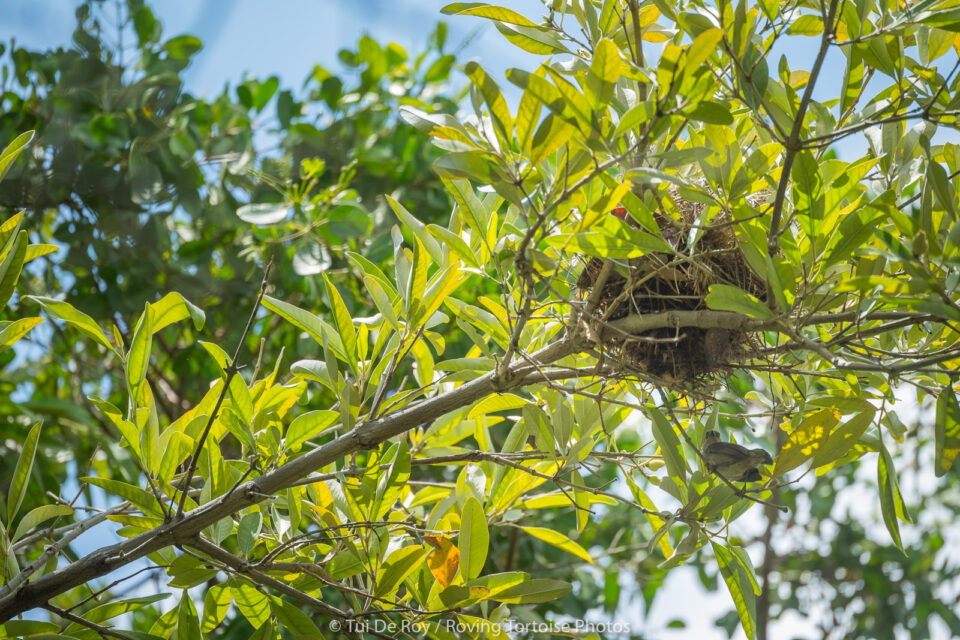

Mangrove Finch Project update
Like many projects in Galapagos, the Mangrove Finch Project was interrupted this year by the COVID-19 lockdown. The consequences for the mangrove finch population are predicted to have been poor and may never be known even if the team can return to the field in 2021.
Like many projects in Galapagos, the Mangrove Finch Project was interrupted this year by the COVID-19 lockdown. The consequences for the mangrove finch population are predicted to have been poor and may never be known even if the team can return to the field in 2021.
Introduction
The mangrove finch is the most critically endangered bird in the Galapagos Islands. Its habitat is restricted to two small areas of mangrove forest in the northwest of Isabela island. Its main threats include parasitism by the invasive fly Philornis downsi, the larvae of which feed on nestlings’ blood usually killing them, and predation by invasive rats.

Mangrove finch © M Dvorak/CDF
As usual, the team arrived on Isabela island in February, planning on staying at the field site for nine weeks. This year there were three staff from the Charles Darwin Foundation (CDF), one Ecuadorian volunteer, two CDF collaborators and one Galapagos National Park ranger.
This was the fourth season of in situ conservation of mangrove finch nestlings. As in previous years, the team aimed to increase the fledging success of nestlings by carefully injecting permacap (an insecticide) into the base of the nests to reduce the number of introduced P. downsi larvae. When a nest can be reached by hand (which is challenging in the tall spindly mangroves!), the team also check the chicks and physically remove any parasites that are present.
In addition to increasing the chances of survival of the finch nestlings, the team trialled, for the first time, providing supplementary food to adult birds to see if this could a) bring more females into breeding condition and b) increase the provision of food to the chicks, thereby giving them an increased chance of survival.
Field work
As usual, the team undertook a mangrove finch population survey. From this they identified 14 breeding pairs, a slight increase from previous years, and 20 solitary males across the two sites. They found a total of 38 colour-ringed birds, including three that had been hand-reared between 2014-2017 and including identifiable territorial non-ringed birds, a total of 50 adults were observed. Results from this survey, including observations of cryptic juvenile birds, enabled the team to estimate that the total mangrove finch population remains around 100 individuals.
The project aimed to inject all mangrove finch nests found with insecticide. The team found 14 nests and managed to inject some of them. By the time the team left, nine nests were still active and two pairs, with previously failed nests, were rebuilding. Excitingly, one of the nests had a hand-reared female from 2016, who was breeding for the third consecutive year, showing the effectiveness of the head-starting programme that occurred between 2014 and 2017. In addition, the team identified a male finch that was ringed in 2006, which was seen singing and building a nest paired with a female that fledged from an insecticide-treated nest in 2018.

Treating a mangrove finch nest with insecticide © Agustin Gutierrez/CDF
Francesca Cunninghame, leader of CDF’s Mangrove Finch Project, commented, “We were delighted to observe the old male again, especially considering that he is over 14 years old.” She added, “From the 2020 breeding season monitoring results we can confirm at the time we had to leave the field that there were four nests with eggs, five with nestlings and unfortunately, due to a range of factors, five nests that had failed early in the season”.
Leaving the field site early
Sadly, however, after just four weeks, the team had to leave the field site with less than a day and a half notice as the Galapagos Islands went into lockdown due to the COVID-19 pandemic. This meant that they were unable to undertake a full season’s population monitoring, complete a baseline mangrove habitat assessment or finish the supplementary feeding trials. Based on results from previous years, without the full set of nest injections, intensive parasite removal and supplementary chick feeding throughout the duration of the nestling period, it is unlikely that there were successful fledglings this season.

Mangrove finch fledgling © Francesca Cunninghame
This is extremely worrying for a critically endangered population with only 14 breeding pairs. Of added concern the team were not able to gain any results from the injections this year and whether any chicks fledged in early 2020 will be extremely difficult to determine. The team will only find out what happened this year when they return to the field site in early 2021. However, working in the species’ favour, the mangrove finch is a long lived species with ongoing high fertility, so while there are fewer than 20 breeding pairs; it is assumed that these individuals will be present and breeding again when the team returns to the field site in early 2021.
“In some cases, the COVID-19 pandemic is giving the natural world some breathing space and providing increased space for wildlife. However, in the case of the mangrove finch, the impacts of the pandemic are working against the species. Like several threatened species, these finches now urgently depend on human support for their survival.” Francesca Cunninghame
Ways you can help
Please help our efforts to conserve the mangrove finch, and other endangered species of Galapagos in these unprecedented times by donating to GCT.
Related articles


Mangrove Finch Project update

Mangrove Finch Project Update


